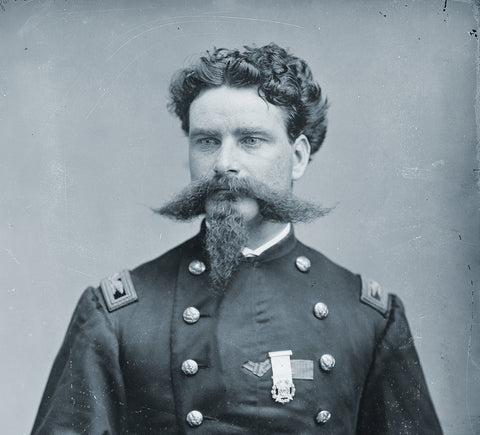
You Know Him for His Facial Hair. But You Might Not Know the Tale of His Tragic Death.
On January 25, 1879, a crowd estimated in the thousands packed inside Dalhousie Park in the Burmese city of Rangoon to experience what was promised to be a resplendent event—Percy Wyndham’s ascent in a hot-air balloon that the dashing, former Civil War colonel had personally constructed. What they witnessed instead was pure horror.
The son of a British cavalry captain—born in 1833 aboard HMS Arab en route to Calcutta—Wyndham undoubtedly had always been a showman. His time in the Union Army, which followed stints in several European nations’ militaries, would be relatively brief. After spending time as a midshipman in the French Navy, he served for eight years as a second lieutenant in the Austrian Army. In 1860, he joined Italian revolutionary Giuseppe Garibaldi’s “Redshirts” in Italy—made a chevalier of the Military Order of Savoy by King Victor Emmanuel II of Sardinia for his distinguished service. A year later, he traveled to America to offer his services to the U.S. government.
In February 1862, New Jersey Governor Charles S. Olden appointed Wyndham colonel of the 1st New Jersey Cavalry. During the Battle of Good’s Farm (Va.), on June 6, 1862, Wyndham fell into Confederate hands after his horse was shot beneath him during a charge. While in captivity, Wyndham would be recognized and embraced by an old comrade, Confederate Major Chatham Roberdeau Wheat, who had served with him during Garibaldi’s campaigns in Italy.
Paroled in August, Wyndham returned to his cavalry brigade. At the June 9, 1863, Battle of Brandy Station, he was severely wounded in the right leg, and sidelined for the upcoming Battle of Gettysburg.
In September 1863, Maj. Gen. Joseph Hooker recommended Wyndham for promotion to brigadier general; however, Secretary of War Edwin M. Stanton suspected that the soldier of fortune was plotting against the U.S. government and banished him from the Army. The accusation was never substantiated, but in July 1864, Wyndham mustered out of the Army, having never received his promotion.
He opened a fencing school in New York City, but returned to Italy when war broke out there in 1866, and then headed to Calcutta, where in 1872 he started the satirical magazine The Indian Charivari. A victim, however, of some poor investments, he eventually faced financial ruin and moved on to Burma.
It was there in Rangoon, on that January day in 1879, that Wyndham would be killed. The well-publicized balloon ascent was a promising financial venture, as individuals, for a small fee, were welcome to tour the 70-foot-tall contraption he had built. On his first attempt, Wyndham was reportedly 500 feet in the air when the balloon burst apart, sending him crashing into a lake below. Wyndham’s body was pulled from the debris, and two doctors from the crowd attempted unsuccessfully to resuscitate him. Bleeding from the nose and mouth, with a fractured skull, Wyndham likely had already been asphyxiated to death by the burning straw and oil before even hitting the water—no one was sure.
On February 9, 1879, Wyndham’s remains were placed in a coffin of polished teak, with gilt mounts, and interred in what is now an unmarked grave in Rangoon’s town cemetery. Shrouded Veterans is working with the British Association for Cemeteries in South Asia (BACSA) and the U.S. Embassy in Rangoon to locate his gravesite.
